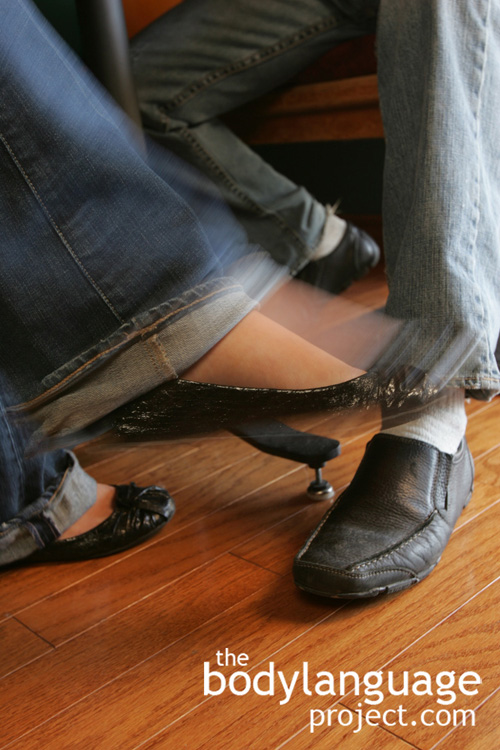
Our toes point to where our mind thinks. Extending our foot in the direction of another person shows we’re thinking that way.
The legs and feet are excellent predictors about what our minds and bodies wish to do, but haven’t yet had the motivation to implement. Just like fingers can and do point when directing the attention of others, so too, can the feet. As it applies to the feet, however, the signal is leaked by accident, rather than on purpose. Our feet lead us everywhere we go, but even while seated they tell others the direction we plan to head once the right circumstances or opportunity presents itself. If you want to know if someone really likes you and is interested in fully inviting you in for discussion, just watch their feet. While seated, if they just swivel their hips in your direction, but keep their feet planted facing away from you, then you know that they aren’t totally immersed. This is likely so because we’ve been programmed by our culture to be polite, so we do our best to engage other people, even if we do it in jest. How rude would it be to point our bodies away from someone who wishes to speak with us? No doubt, this too happens, but is much more obvious and so requires less skill in reading.
This sort of orientation is universal across interactions, the hips up will orient to face whoever is speaking with us, but what happens below, is subject of true interest. Studies covering courtroom behaviour has shown that when juries don’t like a particular witness they will orient their feet toward the door or nearest exit, while the rest of their bodies politely face the witness. As the strength of conversations wax and wane, feet will engage and disengage. This is why we say that interested people put their “whole body into the conversation.” If you can engage them in interesting dialogue then you’ll be able to have them reorient their feet toward you and perhaps even extend a foot in your direction. If you notice feet being moved toward an exit or away from you, try to decipher the cause, as this will tell you why they’ve become disinterested. Disinterest can be for any number of factors, including hearing something offensive, disinterest in the topic or conversation as a whole, or even being late for an engagement. The feet won’t tell you why someone is disinterested, only that someone is disinterested.
As we saw in the previous section, leg crossing predicts relationships since we tend to cross towards our spouses, and our dates, but legs and feet can also cross toward someone we feel is attractive. While we might not physically take steps in the direction of our interest due to shyness, or perhaps because we are already committed, our feet are permitted to do so because it is less obvious to others. Besides, feet pointing does not always guarantee that anything proactive will ever take place. In other words, the feet just point to where we wish to be, but won’t necessarily ever get to.
In stressful situations that people wish to avoid like waiting to see the dentist or doctor, we’ll see toes pointing to the exit. Other times we see prominent toe pointing is when someone wants to end a conversation. It can be annoying to have to do multiple good-bye sequences with someone who seems to have nothing better to do than to ramble on. So instead of reorienting your body toward them, instead aim your feet and shoulders toward the exit. If that doesn’t speed things up or send a clear message, make it more obvious by widening the gap by stepping away.
Legs and feet can also become jittery and fidget when a person is bored and wants to leave. Jittery though can also be due to nervous energy or even the result of happiness such as “happy feet.” It is the context that will help decide what feet and legs are telling in this type of body language.



